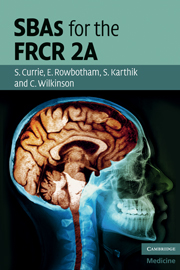Book contents
- Frontmatter
- Contents
- List of contributors
- Preface
- Introduction
- Module 1 Cardiothoracic and vascular
- Questions
- Answers
- Module 2 Musculoskeletal and trauma
- Module 3 Gastro-intestinal
- Module 4 Genito-urinary, adrenal, obstetrics & gynaecology and breast
- Module 5 Paediatric
- Module 6 Central nervous and head & neck
- References
- Index
Questions
Published online by Cambridge University Press: 06 July 2010
- Frontmatter
- Contents
- List of contributors
- Preface
- Introduction
- Module 1 Cardiothoracic and vascular
- Questions
- Answers
- Module 2 Musculoskeletal and trauma
- Module 3 Gastro-intestinal
- Module 4 Genito-urinary, adrenal, obstetrics & gynaecology and breast
- Module 5 Paediatric
- Module 6 Central nervous and head & neck
- References
- Index
Summary
1. A 50 year old male presents with a history of occasional haemoptysis and exertional shortness of breath which has been getting progressively worse. Plain chest radiograph demonstrates bibasal reticular shadowing with volume loss. HRCT demonstrates bibasal fibrosis and traction bronchiectasis. Incidental note is made of a patulous oesophagus. Which of the following is the most likely cause?
a. Tuberculosis
b. SLE
c. Rheumatoid arthritis
d. Wegener's granulomatosis
e. Scleroderma
2. A 35 year old woman presents with chest infection and pyrexia and the plain film reveals dense lobar consolidation with bulging fissures. The likely micro-organism is:
a. Legionella pneumophila
b. Pneumocystis carinii
c. Staphylococcus
d. Streptococcus
e. Klebsiella
3. A 40 year old has a routine chest radiograph as a part of pre-immigration work up. This demonstrates a mass on the left with loss of the upper left heart border. The descending aorta can, however, be seen despite the mass. Which of the following is the most likely location of the mass?
a. Apico-posterior segment
b. Lingula
c. Anterior segment of the upper lobe
d. Posterior basal segment of the lower lobe
e. Lateral basal segment of the lower lobe
4. In an investigation for lung malignancy, all of the following may produce a false positive result on a PET-CT except:
a. Pulmonary hamartoma
b. Intralobar sequestration
c. Tuberculosis
d. Pneumonia
e. Scarring
5. A 70 year old man, previously working in a ship-building yard, presents with progressive breathlessness. Chest radiograph demonstrates bilateral calcified pleural plaque disease with volume loss. Lung function shows a restrictive pattern. HRCT reveals pulmonary fibrosis. The most likely site of these changes would be:
a. Perihilar
b. Apical
c. Peribronchial
d. Subpleural
e. Fissural
6. A 35 year old man undergoes autologous bone marrow transplantation following successful treatment of lymphoma.
- Type
- Chapter
- Information
- SBAs for the FRCR 2A , pp. 1 - 13Publisher: Cambridge University PressPrint publication year: 2010



